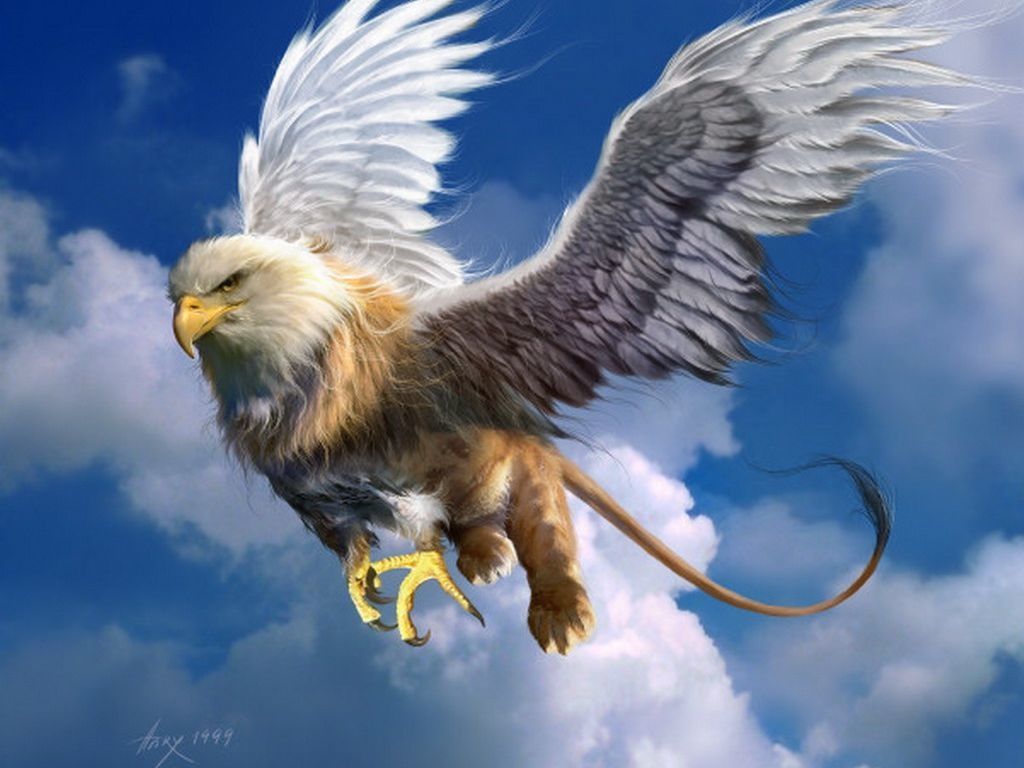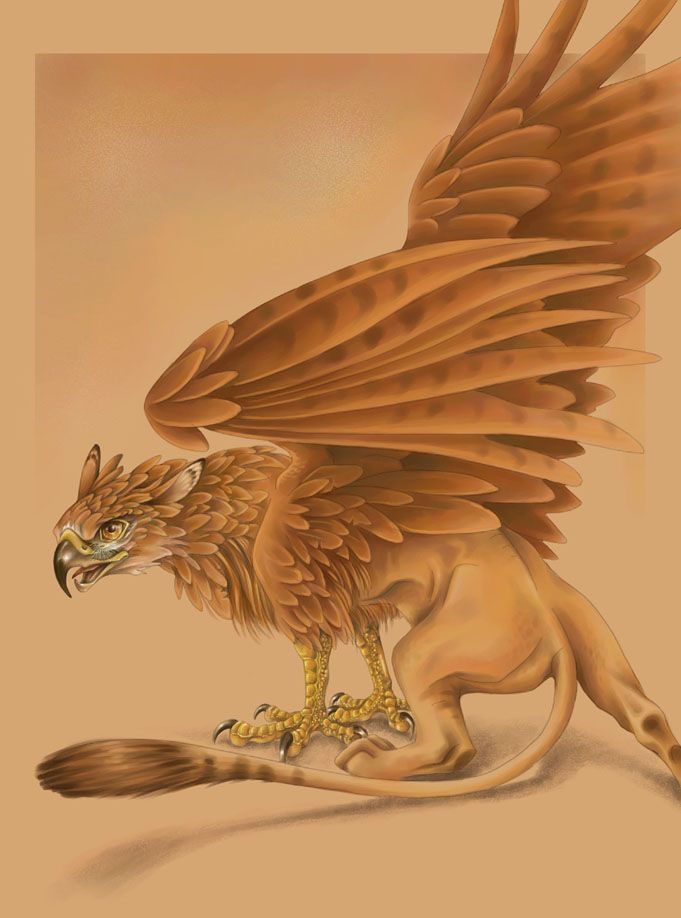GRIFFON/GRIFFIN

Le griffon ou grype est une créature fantastique présente dans plusieurs cultures anciennes. Il est imaginé et représenté avec une forme tenant de l'aigle à l'avant (tête, ailes et serres) et du lion à l'arrière. Avec quelquefois des variantes le griffon gardera de tout temps la particularité reconnaissable d'être hiéracocéphale.

Le griffon intègre sans difficulté le monde du Moyen Âge. Il est en effet considéré comme un animal réel appartenant au genre des oiseaux, et personne ne parait douter de son existence. Il se rencontre très tôt dans l’art et la littérature chrétienne. Il gagne ensuite l'ensemble des formes d’art et des régions occidentales, fait l’objet de nombre de commentaires savants dans les bestiaires et encyclopédies médiévales, et parcourt même plusieurs œuvres littéraires romanesques. Citons, entre autres, le commentaire d'Isidore de Séville dans ses Étymologies, qui trouve des répercussions durant tout le Moyen Âge, ou encore certaines versions du Roman d'Alexandre. Le griffon ne bénéficie que d'un symbolisme réduit.

Vers la fin du Moyen Âge, le griffon est utilisé dans des armoiries. Nombreux sont les écussons ornés de têtes, ou de corps complet représentant le griffon. Armundal, baron de Navarre, y ajouta ces phrases : « Bonne instance, mon royaume et mon chez moi, se doivent de s'enguorneilir du protecteur qu'il se doit. »
Il est également gravé par Martin Schongauer et Albrecht Dürer.

The griffin (griffon or gryphon (see below)) is a legendary creature with the body of a lion and the head and wings of an eagle. As the lion was traditionally considered the king of the beasts and the eagle was the king of the birds, the griffin was thought to be an especially powerful and majestic creature. Griffins are normally known for guarding treasure. In antiquity it was a symbol of divine power and a guardian of the divine.
Most contemporary illustrations give the griffin legs like an eagle's legs with talons, although in some older illustrations it has a lion's forelimbs; it generally has a lion's hindquarters. Its eagle's head is conventionally given prominent ears; these are sometimes described as the lion's ears, but are often elongated (more like a horse's), and are sometimes feathered.
Infrequently, a griffin is portrayed without wings (or a wingless eagle-headed lion is identified as a griffin); in 15th-century and later heraldry such a beast may be called an alce or a keythong. In heraldry, a griffin always has forelegs like an eagle's; the beast with forelimbs like a lion's forelegs was distinguished by perhaps only one English herald of later heraldry as the opinicus. The modern generalist calls it the lion-griffin, as for example, Robin Lane Fox, in Alexander the Great, 1973:31 and notes p. 506, who remarks a lion-griffin attacking a stag in a pebble mosaic at Pella, perhaps as an emblem of the kingdom of Macedon or a personal one of Alexander's successor Antipater.
A 9th-century Irish writer by the name of Stephen Scotus[citation needed] asserted that griffins were strictly monogamous. Not only did they mate for life, but if one partner died, the other would continue throughout the rest of its life alone, never to search for a new mate. The griffin was thus made an emblem of the Church's views on remarriage.
Being a union of a terrestrial beast and an aerial bird, it was seen in Christianity to be a symbol of Jesus, who was both human and divine. As such it can be found sculpted on churches.
According to Stephen Friar, a griffin's claw was believed to have medicinal properties and one of its feathers could restore sight to the blind.Goblets fashioned from griffin claws (actually antelope horns) and griffin eggs (actually ostrich eggs) were highly prized in medieval European courts.
Since its emergence as a major seafaring power in the Middle Ages and Renaissance griffins have been depicted as part of the Republic of Genoa's coat of arms, rearing at the sides of the shield bearing the Cross of St. George.
By the 12th century the appearance of the griffin was substantially fixed: "All its bodily members are like a lion's, but its wings and mask are like an eagle's." It is not yet clear if its forelimbs are those of an eagle or of a lion. Although the description implies the latter, the accompanying illustration is ambiguous. It was left to the heralds to clarify that.


Le griffon intègre sans difficulté le monde du Moyen Âge. Il est en effet considéré comme un animal réel appartenant au genre des oiseaux, et personne ne parait douter de son existence. Il se rencontre très tôt dans l’art et la littérature chrétienne. Il gagne ensuite l'ensemble des formes d’art et des régions occidentales, fait l’objet de nombre de commentaires savants dans les bestiaires et encyclopédies médiévales, et parcourt même plusieurs œuvres littéraires romanesques. Citons, entre autres, le commentaire d'Isidore de Séville dans ses Étymologies, qui trouve des répercussions durant tout le Moyen Âge, ou encore certaines versions du Roman d'Alexandre. Le griffon ne bénéficie que d'un symbolisme réduit.

Vers la fin du Moyen Âge, le griffon est utilisé dans des armoiries. Nombreux sont les écussons ornés de têtes, ou de corps complet représentant le griffon. Armundal, baron de Navarre, y ajouta ces phrases : « Bonne instance, mon royaume et mon chez moi, se doivent de s'enguorneilir du protecteur qu'il se doit. »
Il est également gravé par Martin Schongauer et Albrecht Dürer.

The griffin (griffon or gryphon (see below)) is a legendary creature with the body of a lion and the head and wings of an eagle. As the lion was traditionally considered the king of the beasts and the eagle was the king of the birds, the griffin was thought to be an especially powerful and majestic creature. Griffins are normally known for guarding treasure. In antiquity it was a symbol of divine power and a guardian of the divine.
Most contemporary illustrations give the griffin legs like an eagle's legs with talons, although in some older illustrations it has a lion's forelimbs; it generally has a lion's hindquarters. Its eagle's head is conventionally given prominent ears; these are sometimes described as the lion's ears, but are often elongated (more like a horse's), and are sometimes feathered.
Infrequently, a griffin is portrayed without wings (or a wingless eagle-headed lion is identified as a griffin); in 15th-century and later heraldry such a beast may be called an alce or a keythong. In heraldry, a griffin always has forelegs like an eagle's; the beast with forelimbs like a lion's forelegs was distinguished by perhaps only one English herald of later heraldry as the opinicus. The modern generalist calls it the lion-griffin, as for example, Robin Lane Fox, in Alexander the Great, 1973:31 and notes p. 506, who remarks a lion-griffin attacking a stag in a pebble mosaic at Pella, perhaps as an emblem of the kingdom of Macedon or a personal one of Alexander's successor Antipater.
A 9th-century Irish writer by the name of Stephen Scotus[citation needed] asserted that griffins were strictly monogamous. Not only did they mate for life, but if one partner died, the other would continue throughout the rest of its life alone, never to search for a new mate. The griffin was thus made an emblem of the Church's views on remarriage.
Being a union of a terrestrial beast and an aerial bird, it was seen in Christianity to be a symbol of Jesus, who was both human and divine. As such it can be found sculpted on churches.
According to Stephen Friar, a griffin's claw was believed to have medicinal properties and one of its feathers could restore sight to the blind.Goblets fashioned from griffin claws (actually antelope horns) and griffin eggs (actually ostrich eggs) were highly prized in medieval European courts.
Since its emergence as a major seafaring power in the Middle Ages and Renaissance griffins have been depicted as part of the Republic of Genoa's coat of arms, rearing at the sides of the shield bearing the Cross of St. George.
By the 12th century the appearance of the griffin was substantially fixed: "All its bodily members are like a lion's, but its wings and mask are like an eagle's." It is not yet clear if its forelimbs are those of an eagle or of a lion. Although the description implies the latter, the accompanying illustration is ambiguous. It was left to the heralds to clarify that.

